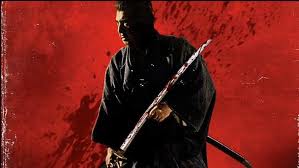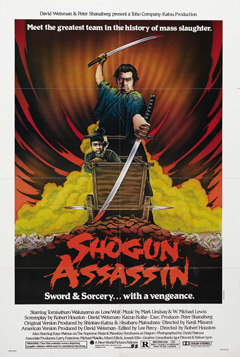
 |
|
|
|
By now any fan who cares about samurai pictures should know the history of the legendary Sword of Vengeance movies, a six-title Japanese samurai epic about a shogunate executioner turned renegade ronin. Pushing his toddler son in a wooden baby cart, this swordsman wanders the roads of Japan to fight duels with the hated killers of the Yagyu Clan, the murderers of his family. The present-day fan boy demographic has been steered to these ultra-violent slice 'n' dice epics by their association with Quentin Tarantino's Kill Bill. For a while there, Tarantino would only have to mention an example of 70s exploitation and his fan base would start looking for it. The Sword of Vengeance films are still highly potent exercises in outrageous fantasy swordplay. Their beautifully choreographed and photographed sword combat can convince the viewer that one stout but phenomenally gifted artiste can beat five or more opponents to the draw, chopping heads, severing limbs and splitting torsos like firewood. 
At the time they were first shown, this series was an all-out sensory attack. Remember that in 1972 the gore level of movies was far lower than it would be just a few years later; even fans of Italian Giallo pictures often watched prints censored to appease the MPAA rating system. In 1974 I happened to catch #4, Baby Cart in Peril, at the long-defunct Kokusai theater down on Crenshaw in Los Angeles. On a big screen in sparkling Fujichrome, beautiful images of close-up tattooing made a strange aesthetic contrast with the film's jaw-dropping scenes of mayhem. But these bloody thrills could be shared only by those lucky enough to live in cities with a Japanese-language neighborhood theater. The showings might be listed in newspapers as "Baby Cart", "Sword of Vengeance" or "Lone Wolf and Cub" movies -- or in Japanese. And American fans lucky enough to discover the films were unlikely to realize that they were sourced in an unending series of violent Japanese Manga comic novels, or that they were produced by Shintaro Katsu, the wealthy star of the Zatoichi "blind swordsman" series. The third Sword of Vengeance film apparently circulated in exploitation theaters in a poorly dubbed version called Lightning Swords of Death, but to see more the general American audience would have to wait until 1980 for the highly successful release of Shogun Assassin. Shogun Assassin is a slick adaptation of the first two films in the series, Kozure ôkami: Ko wo kashi ude kashi tsukamatsuru and Kozure ôkami: Sanzu no kawa no ubagurum. The American importers cut the films down and added English dialogue (by David Weisman). The running time was chopped in half, eliminating the complicated political double-cross that ensnares the shogun's executioner Ogami Itto (Tomisaburo Wakayama). Left untouched are the many sword duels and ambushes, leading up to the original bravura finish of Sword of Vengeance #2. On a sea of sand dunes Ogami Itto faces off against three murderous "Masters of Death" (Minoru Oki, Akiji Kobayashi, Shin Kishida) who fight with fearsome spiked weapons. Shogun Assassin introduced us to an exotic Japanese action movie mentality, an eclectic stew of borrowed motifs. From Spaghetti Westerns comes the slow build-up to lightning-fast violence, between lone killers of few or no words. From James Bond comes Ogami Itto's baby cart, a rolling armory that doubles as a gun platform, with built-in cannons, etc. Itto Ogami wears mostly the same dour face throughout. The main point of interest in non-slaughter scenes is Ogami's bizarre relationship with his son Daigoro (Akihiro Tomikawa), who is first seen as a baby who can hardly walk. The famous opening shows the stoic Ogami Itto sitting with his baby son. His wife has been murdered, and Itto has sworn himself to a life of vengeance. What will become of Daigoro? Itto places two objects in front of the child, a colorful ball and the knife. If Daigoro chooses the ball Itto will kill him and go on alone. If he chooses the knife, he will accompany his father on the road. 
The films use Daigoro in interesting, unexpected ways. The big Daigoro moment in Shogun Assassin is when the caravan of a wicked inspector is crossing the sand dunes. They stop at the sight of the tiny boy standing alone on a rise in the sand. Daigoro points off to the left, we cut to a powerful image of Ogami Itto atop a sand dune, challenging the Masters of Death to stand and fight. Shogun Assassin is an excellent introduction to the Sword of Vengeance series. The dubbing is quite good, especially considering that the speech in the original is often broken up into tiny bites of dialogue. Ogami Itto himself often just grunts. Instead of doing things the cheap way, the original producers hired talent like Lamont Johnson, Marshal Efron and Sandra Bernhard to dub the voices. Voicing Itto's main female adversary, Bernhard produces one of the better-dubbed laughs in film history. A narration was added, spoken by the otherwise slient Daigoro. An entire new disco-inflected soundtrack was devised to help the film seem more like a sword 'n' sorcery story -- in 1980, Samurai films had yet to gain a foothold in America. The original films are certainly more artistic, and I think the original music tracks work better as well. But Shogun Assassin helped popularize ultra-violent Japanese Samurai films in the States. The re-tooled version doesn't diminish the over-the-top bloodletting one bit. AnimEigo's Blu-ray of Shogun Assassin continues the label's excellent work on DVD. The Hi-Def transfer was made by editing clean HD video from the Japanese originals over the contrasty, duped 1980 cut-down version. The professional, polished 1980 English track syncs up perfectly. Disc producer Aaron Cavazos explains that AnimEigo has released all six Sword of Vengeance movies and their five Shogun Assassin counterparts on DVD; I hope that they continue in the same vein with Blu-ray. Although I prefer original language versions of foreign films, the adapted and dubbed Shogun Assassin has such a strong following in this country that it shouldn't be suppressed. To continue the series, AnimEigo engineered new voice tracks for the Japanese original 3-6 and renumbered them 2-5 to fit into the Shogun Assassin pattern. 1 As Mr. Cavazos says, "The Shogun Assassin series is strictly for audiences who prefer not to read while they watch limbs being chopped off." This new Blu-ray also continues the AnimEigo tradition of useful, authoritative extras. Since the tale of Ogami Itto and Daigoro is a total fantasy, the historical notes are thin this go-round. A critical commentary track is by Ric Meyers and Steve Watson, a martial arts expert. Viewer curiosity will find a lot of answers in a second commentary by the film's producer David Weisman, with input from Jim Evans, a graphic designer, and Gibran Evans, who dubbed the voice of Diagoro when he was seven years old. Weisman explains how he put together the deal to import and re-cut the film. The title was suggested when the movie went to New World for distribution -- the TV miniseries Shogun had recently premiered on television. Samuel L. Jackson is apparently a huge fan of the Lone Wolf and Cub movies and explains his feelings about them in a videotaped interview. We also get a trailer and an image comparison, between a bootleg, the DVD and the much clearer Blu-ray release.
On a scale of Excellent, Good, Fair, and Poor,
Shogun Assassin Blu-ray rates:
Footnotes:
1. Actually, Shogun Assassin 2 may use the voice track recorded for the U.S. release Lightning Swords of Death.
Reviews on the Savant main site have additional credits information and are often updated and annotated with reader input and graphics. Also, don't forget the 2010 Savant Wish List. T'was Ever Thus.
Review Staff | About DVD Talk | Newsletter Subscribe | Join DVD Talk Forum |
| ||||||||||||||||||